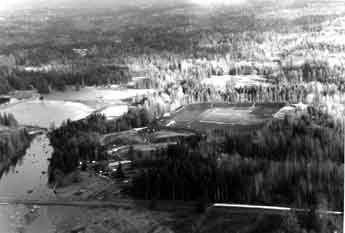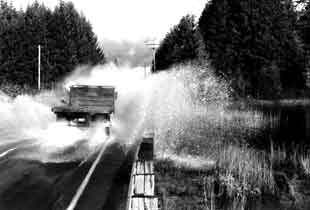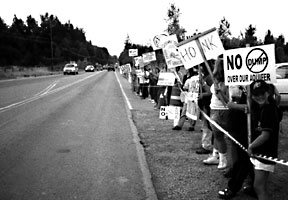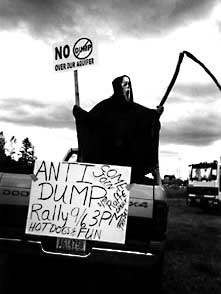Trashing Public Interest
A huge garbage landfill is being built right on top of the drinking water supply for 700,000 Pierce County residents
by Art Perkins and Jennifer Moon, Free Press contributors
For over a decade, Resource Investments, Inc. (RII), a private landfill company, has proceeded to develop a landfill in central Pierce County over continuous local opposition. That in itself is not unusual; landfills, though necessary, are often a source of controversy. This one, however, encroaches upon more than 20 acres of prime wetlands. Moreover, this dump is located adjacent to a salmon-bearing stream. To make matters even worse, it is placed directly over a major sole-source aquifer that serves approximately half a million residents of Pierce County. Under a recent state law, any new such landfill would now be illegal.
The landfill, at 304th and Meridian Streets, became operational in December 1999. The story behind its creation is a complex one, involving numerous legal actions, jurisdictional battles between local and federal officials, political intervention by five members of Washington's congressional delegation, the enactment of state legislation to prevent it, and extensive debate about the economics and environmental impact of waste disposal. The story begins in the late 1980s when Pierce County, seeking to determine its future course for waste management, developed the Tacoma-Pierce County Solid Waste Management Plan. The Hidden Valley Landfill, which had handled solid waste disposal in the County, was reaching full capacity and was scheduled to close in 1996. The County created a Solid Waste Advisory Committee, which included representatives of the waste management industry, to recommend its landfill policies. The resulting plan adopted by the County stated that Pierce County would seek to dispose of its solid waste via in-county landfill. Waste export, or long hauling of waste, would be pursued only as a last resort.
Working in tandem with Land Recovery, Inc. (LRI), an affiliate of RII that handles solid waste disposal facilities in Pierce County, the county government settled upon a proposed landfill location at the 304th Street site and began the permitting process. Because the site included approximately 70 acres of wetlands, about 22 of which would be directly affected by the proposed landfill, the permitting process triggered a review by the U.S. Army Corps of Engineers under Section 404 of the federal Clean Water Act. Section 404 prohibits the discharge of dredged or fill material in wetland areas whenever there is a "practicable alternative" that would have less of an impact on the aquatic ecosystem.
The Corps received the initial permit application from RRI in 1990 and, in 1992, issued a public notice about the proposed landfill. In response, the Corps received hundreds of letters in opposition to the landfill. Concerns raised included the impact on traffic flow through the area, the effect the project would have on the site's wetlands, the aesthetic and visual impacts of the proposed project, and the threat the project posed to native chum salmon.
Although RII/LRI planned to mitigate wetland loss by dedicating 85 acres of the site to wetland creation and preservation, the U.S. Fish and Wildlife Service (FWS) expressed concerns about the feasibility of the company's plan. According to the U.S. Army Corps of Engineers' "Record of Decision for Resource Investments, Inc.," the FWS "stated that a review of created or restored forested wetland habitats on a nationwide basis shows that type of mitigation has been unsuccessful. The FWS stated that the creation of forested wetlands as mitigation would likely take a minimum of 20 years, with no guarantee of functional replacement at the end of the project."
The Nisqually Tribe also expressed concerns about the impact of the landfill on Muck Creek, a tributary of the Nisqually River, which lies adjacent to the site. The Tribe wrote that "...Muck Creek supports the largest return of tributary spawned chum salmon in the Nisqually River basin."

Aerial photo of the initial landfill construction (center right) and nearby Muck Creek (left), with Highway 161 in foreground. the water table is close to the landfill, raising fears of groundwater contamination. During partial flooding, as in these december 1999 photos, the water is even higher.
|
Gambling with the Water Supply
The issue that generated the most opposition to the proposed project, however, was the potential environmental impact of the landfill on the sole-source aquifer upon which the 304th Street landfill sits. Opponents of the landfill, which included the U.S. Environmental Protection Agency, questioned the company's plans to prevent groundwater contamination and the contamination of South Muck Creek.
Although the natural groundwater gradient is downward, RII/LRI contended that it could create and maintain an upward gradient flow at the landfill. A leak detection and collection system (LDCS) would protect the aquifer from leachate contaminants, essentially solid waste sludge or garbage "juice." The Corps of Engineers, however, determined that the leak detection/collection system "would be constructed below the water table and within 35 feet of the sole source aquifer.... [P]rotection of the Central Pierce County Aquifer System would be entirely dependent on the continuous, unfailing maintenance of an artificially induced upward gradient everywhere under the landfill.... Therefore, a relatively minor malfunction of the LDCS could potentially result in significant contamination in downgradient water supply wells." The Corps additionally questioned the company's liner leakage rate calculations, which, the Corps maintained, would be lower "than any documented leakage rate at an existing landfill."
After a thorough examination of the potential impacts associated with the landfill, the Corps denied the landfill permit in September 1996. Colonel Donald Wynn of the Corps wrote in the Record of Decision that RII had "failed to clearly demonstrate that there are no less environmentally damaging practicable alternatives for achieving the project purpose; and thus, the project does not comply with the Section 404(b)(1) Guidelines [of the Clean Water Act].... I have also determined that the proposed project, as designed, represents an unacceptable risk to public health and safety due to the potential contamination of the Central Pierce County Aquifer System... Based on the above findings, the proposed work is not in the public interest."

Wynn backed up his statement with 86 pages detailing how he and his staff had reached that conclusion, along with 140 additional pages of technical summary. The analysis included analysis of groundwater, surface hydrology, surface water quality, flooding, traffic, air quality, aesthetics, social impacts, and wetland mitigation.
In his analysis of practicable alternatives, Colonel Wynn pointed to the failure of RII and Pierce County to consider the option of alternative in-county sites or long hauling. The Corps indicated that it had examined two siting studies previously conducted by Pierce County and RII/LRI which had identified a total of eleven potential sites for an in-county landfill. All of the sites appeared to be consistent with the Tacoma-Pierce County Solid Waste Management Plan. The Corps stated that "It is the responsibility of the Applicant to clearly demonstrate that any of these sites are not available." In the view of the Corps, RII/LRI had failed to do so.
The Corps also focused much of its "practicable alternatives" analysis on the long haul option. Long hauling of solid waste to eastern Oregon and eastern Washington involves the transport of solid waste to a central transfer station. The waste is then loaded into rail cars and transported to landfills on the eastern side of the Cascade range, where the drier climate decreases the likelihood of leachate contamination.
RII/LRI and Pierce County have adamantly opposed the long haul alternative as economically unfeasible. Although Pierce County contracted with LRI to longhaul 40 percent of its solid waste to eastern Washington in the mid-1990s, the County and RII/LRI maintain that the long haul alternative is too costly and would result in a burden to Pierce County's ratepayers. The company estimated that the long hauling option would cost approximately $70 million to $85 million more per year than disposing of waste at an in-county landfill, totaling upwards of $1.5 billion over the landfill's 20-year "life expectancy."
Both the Corps and the Environmental Protection Agency, however, questioned the company's cost figures. The City of Seattle and Snohomish County, the Corps pointed out, found it economically feasible to long haul their solid waste. In addition, Pierce County contracted with a consultant, Parametrix, Inc., in 1994 to develop an estimate of costs if the County long hauled 100 percent of its solid waste. According to the Corps' Record of Decision, "This estimate calls for a 24 percent to 57 percent increase over the life of the project.... If the 24 percent to 57 percent increase was amortized over the 20-year life of the project, this would result in an average annual increase from 1.2 percent to 2.85 percent per year, far less than the cost increases estimated by Pierce County and RII." Based on this information, the Corps concluded that "the average annual increases for solid waste disposal would be significantly less than estimates provided by the Applicant and Pierce County. The Parametrix estimates do not suggest that the costs for longhaul are unreasonable."
Colonel Wynn noted in the Record of Decision that, although the Corps repeatedly requested that the company provide information demonstrating why long hauling or alternate sites within the county were not "practicable alternatives," the company had failed to provide such information when requested. In regard to both the long haul issue and the alternate site option, the company indicated to the Corps that it already had adequate information upon which to base its decision.
Prior to the Corps' denial of the permit in 1996, Pierce County Executive Doug Sutherland, currently running for Washington State Public Lands Commissioner, wrote letters to both Colonel Wynn of the Corps and Chuck Clarke, Regional Administrator of the EPA, charging that requiring the County and RII/LRI to consider long hauling as a practicable alternative constituted a federal infringement upon local authority.
Long hauling, Sutherland claimed in his letter to Colonel Wynn, "is neither a practicable, reasonable, or acceptable solid waste management alternative for Pierce County. Private or public proposals for a municipal solid waste landfill should not have to consider waste export as an alternative." The Tacoma-Pierce County Solid Waste Management Plan, he argued, had identified in-county solutions to solid waste disposal as the preferred course. Long hauling would violate the Plan, and "Requiring LRI/RII to consider waste export as an alternative forces the company to act against the wishes of the government legally entitled and responsible for solid waste management planning."
In response to a statement made by an EPA spokesperson questioning the County's opposition to the long haul alternative, Sutherland sent a letter to EPA Regional Administrator Clarke. Sutherland claimed that "Land use decisions must be made by the citizens' locally elected representatives" and chided "persons presuming to speak for a federal regulatory agency [who] make statements which expose a close-minded, paternalistic view of governance." In neither letter did Sutherland address any of the environmental concerns associated with the project or mention the possibility of alternate in-county waste disposal sites that might pose a lesser environmental threat.
The County also found some friends in high places. A letter written to Colonel Wynn signed by Senator Slade Gorton, Senator Patty Murray, Congresswoman Jennifer Dunn, Congressman Randy Tate, and Congressman Norm Dicks claimed that Pierce County had "determined that an in-county landfill would best meet its needs and specifically rejected out-of-county long haul as too costly." They urged the Corps to base its decision on the Section 404 permit "upon the merits of the application, and recognize that an important balance exists between local and federal governments on the issue of waste management." They claimed that "The private sector applicant, RII, has put forward a good faith effort to mitigate the impacts on the wetlands in the area of the proposed landfill."
Sept. 1999 rally of residents concerned about the landfill. Both senators Patty Murray and Slade Gorton have flexed their political muscles on behalf of the company building and operating the landfill.

|

|
Permitting Irregularities
Given that the Corps denied the Section 404 permit in 1996, how did it happen that the landfill, opposed by several federal regulatory agencies and hundreds of local citizens, is now operational? Opponents of the landfill attribute it to legal maneuvering and a tainted permitting process at the county and state levels, and point to permitting irregularities at the Washington State Department of Ecology (DOE) and the Tacoma-Pierce County Health Department (TPCHD) in particular.
The Tacoma-Pierce County Health Department issued a solid waste permit to RII/LRI in February 1996, conditional upon the issuance of a Water Quality Certification by the DOE and issuance of the Section 404 permit by the Corps. According to a sworn deposition on January 23, 1997 before the Pollution Control Hearings Board of a key DOE permitting employee, the Water Quality Certification was issued in 1996 under unusual circumstances. According to this employee, the DOE planned to rely on the Corps' practicable alternatives decision as a prerequisite for its own permitting process, since "The Corps has specialists that do nothing else other than 404(b)(1) Alternatives. So consequently, Ecology does not do this type of process." Prior to the Section 404 determination, however, it became clear that the Corps was likely to challenge the county's alternatives analysis. Before the Corps' Section 404 permit determination had been made and before other required permits had been issued, the DOE granted the Water Quality Certification to RII/LRI. The DOE permitting employee claimed that a supervisor "... wanted this certification out..." and that it had been cleared by then-DOE director Mary Riveland.
Following the denial of the Section 404 permit by the U.S. Army Corps of Engineers in 1996, RII/LRI then launched a legal challenge to the Corps' jurisdiction over landfills. The company's case was eventually heard by the U.S. Ninth Circuit Court of Appeals, which upheld the company's claim in 1998. The Court determined that the U.S. Army Corps of Engineers lacked jurisdiction in its Section 404 review of the landfill. Section 404 of the Clean Water Act pertains to dredged material or fill affecting wetlands. A municipal solid waste landfill, the Court found, does not fit the description of dredged or fill material generally associated with an aquatic environment.
In February 1999, following the decision of the Ninth Circuit Court of Appeals, the TPCHD amended the solid waste permit it had issued in 1996. The amended permit stated that the Section 404 permit was required only "to the extent required by federal and state law." Since the Ninth Circuit Court of Appeals had determined that the Corps lacked jurisdiction, the practicable alternatives analysis appeared to fall to the TPCHD. A TPCHD permitting official subsequently determined that the company had adequately demonstrated that there were no practical alternatives to the 304th Street site.
The amended permit also substituted the Pierce County Department of Planning and Land Services (PALS) for Corps and DOE approval of the company's wetland mitigation plan. PALS had previously come out in support of the landfill project during the Corps' Section 404 permit deliberations. According to the Corps' summation of public comments, PALS had urged the Corps to "give due deference to the County's decision to site a landfill within Pierce County and to their Solid Waste Management Plan in its approach to alternatives (specifically the Longhaul alternative)."
As the TPCHD was issuing an amended solid waste permit for the landfill project in February 1999, the Washington State Legislature was drafting a bill, SSB 5729, that amended the Solid Waste Act to prohibit the landfill at the 304th Street site. Sponsors included State Senator Marilyn Rasmussen, an active opponent of the landfill. Specifically prohibiting new landfills from being developed over sole source aquifers, the bill passed with an emergency clause directing that it take effect immediately. It was signed into law by Governor Gary Locke and took effect April 27, 1999.
One to two weeks prior to the passage of the law, however, construction activities at the site intensified, jumping the gun on the permit. A TPCHD official indicated that he had learned that RRI/LRI had already begun to prepare the site for excavation, even though the TPCHD had not yet approved final construction plans as required by the solid waste permit. The company was then in a position to claim that the law passed on April 27th did not apply since construction had already begun before the bill was passed. Landfill opponents claim that the construction activity was illegal, commencing prior to the issuance of a site development permit on May 27th. Furthermore, RII/LRI had not met the conditions specified in the solid waste handling permit that would have allowed legal construction activities to begin.
Legal wrangling over the $60 million landfill at 304th and Meridian Streets continues. Opponents of the landfill are pinning their hopes for a remedy on the Pollution Control Hearings Board. In the latest development, RII/LRI is now indicating that it may wish to reserve the right to accept waste from outside Pierce County, despite its own often-stated policy of accepting only in-county waste. Although the company claims that it has no such plans for the immediate future, out-of-county waste might someday become an option. Should that ever happen, and should the County attempt to interfere, rate hikes-- and a new round of law suits-- have been threatened.
Art Perkins is co-vice president of Concerned Residents On Waste Disposal (CROWD), a group that has opposed the landfill.



